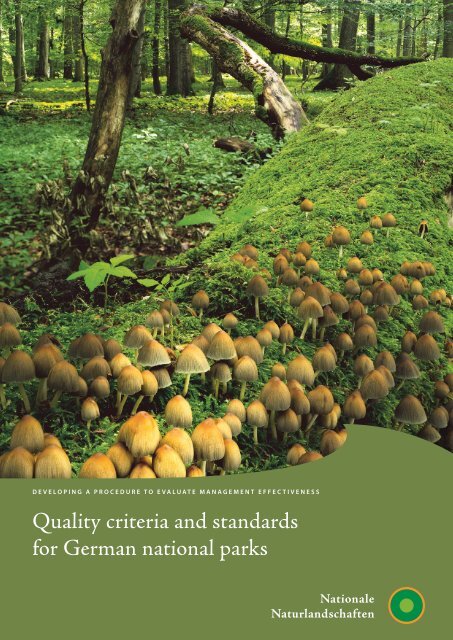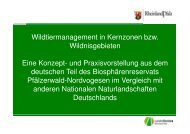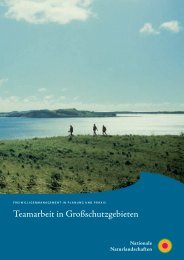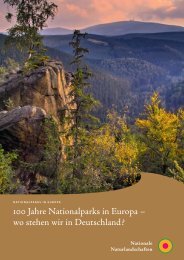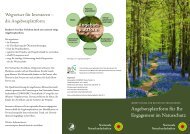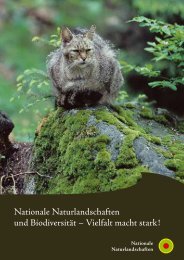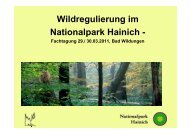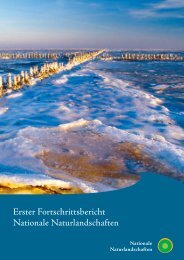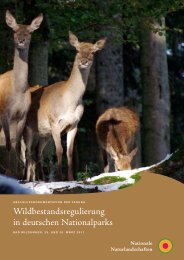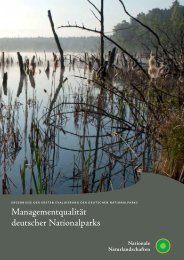Quality criteria and standards for German national parks
Quality criteria and standards for German national parks
Quality criteria and standards for German national parks
- No tags were found...
Create successful ePaper yourself
Turn your PDF publications into a flip-book with our unique Google optimized e-Paper software.
2 | FOREWORDForewordFederal Environment Minister Sigmar GabrielHalting the loss of biological diversity represents as great achallenge as coming to terms with climate change. There<strong>for</strong>e thedecision was taken in Johannesburg in 2002 to aim <strong>for</strong> a significantreduction in the current rate of loss of biological diversityby 2010.A central measure to achieve this goal is the establishment ofa global system of protected areas. Depending on the managementpriorities adopted, this may involve strict nature conservation<strong>and</strong> care or the sustainable use of natural resources, buteach protected area can make its own specific contribution tomaintaining biological diversity.The significance of protected areas, not only <strong>for</strong> the 2010-goalbut also <strong>for</strong> the objectives of the Convention on BiologicalDiversity, is highlighted by the programme of work on protectedareas passed by the 7th Conference of the Parties to the Conventionin Kuala Lumpur. This programme calls on the partiesto the convention to establish <strong>and</strong> maintain a system of protectedareas at the <strong>national</strong> level which is not only ecologicallyrepresentative, but is also effectively managed.there are 14 <strong>national</strong> <strong>parks</strong>, 16 biosphere reserves <strong>and</strong> 100 nature<strong>parks</strong>, which together cover more than 25% of the terrestrial areaof the country. In recent years we have undertaken considerableef<strong>for</strong>ts to develop <strong>criteria</strong> <strong>and</strong> st<strong>and</strong>ards <strong>for</strong> these areas whichare suitable <strong>for</strong> the identification of strengths <strong>and</strong> weaknesses.<strong>Quality</strong> <strong>criteria</strong> <strong>and</strong> st<strong>and</strong>ards are now available <strong>for</strong> our <strong>national</strong><strong>parks</strong>, <strong>and</strong> these are being augmented in the course of anevaluation procedure. This makes it possible <strong>for</strong> us to establisha comprehensive quality management system <strong>for</strong> this protectioncategory. The federal government <strong>and</strong> the federal states (laender)have the common goal of evaluating all <strong>national</strong> <strong>parks</strong> in time<strong>for</strong> the 10th Conference of the Parties in 2010.With the joint ef<strong>for</strong>ts of the laender, the administrations of the<strong>national</strong> <strong>parks</strong> <strong>and</strong> the umbrella organisation EUROPARC<strong>German</strong>y it will hopefully be possible to develop the work in the<strong>national</strong> <strong>parks</strong> further <strong>and</strong> thus to make an important contributionto preserving habitats <strong>and</strong> species.The fact that despite the designation of new protected areaswe have so far not been able to register any change in the trendtowards the loss of species <strong>and</strong> habitats shows just how importantthe effective management of protected areas is. In <strong>German</strong>y
objectives | 5Regional conference, January 2007, Bavarian Forest National ParkAdvisory board meeting, June 2007, Frankfurt Zoological SocietyRegarding <strong>national</strong> <strong>parks</strong>, this means developing an evaluationsystem which takes account of both inter<strong>national</strong> st<strong>and</strong>ards<strong>and</strong> also the <strong>national</strong> situation <strong>and</strong> requirements. For example,the 14 <strong>German</strong> <strong>national</strong> <strong>parks</strong> are relatively young. Neverthelessthey meanwhile constitute a representative selection ofthe key major l<strong>and</strong>scapes in <strong>German</strong>y. Bearing in mind thepredominance of the cultural l<strong>and</strong>scape <strong>and</strong> the few remaining“natural” areas, the consequence is that the <strong>national</strong> <strong>parks</strong> notonly vary in type but are also very different in size, ranging from3003 hectares <strong>for</strong> the Jasmund National Park to the 441,500ha of the Schleswig-Holstein Wadden Sea <strong>national</strong> park. It isalso necessary to consider the various legal provisions, becausethe Federal Nature Conservation Act has so far only provideda <strong>national</strong> framework <strong>and</strong> the laender, which have the responsibility<strong>for</strong> nature conservation, have made various legislativeprovisions <strong>for</strong> <strong>national</strong> <strong>parks</strong> within the federal framework.However, there are not only differences in terms of their nature<strong>and</strong> the legislative framework. Other key areas of distinctionsinclude the ownership, organisational structure, <strong>and</strong> the staffing<strong>and</strong> funding provisions. For this reason, a “status-quo analysis”was carried out as part of the project which provided data from2006 <strong>for</strong> comparison purposes. The in<strong>for</strong>mation gained inthis way established a basis from which st<strong>and</strong>ards <strong>for</strong> <strong>German</strong><strong>national</strong> <strong>parks</strong> were developed.The results of this analysis were on the whole sobering, whichonly confirmed the urgent need <strong>for</strong> action to improve the qualityof the <strong>national</strong> <strong>parks</strong>. In addition to quality assurance, theproject had also set itself the goal of achieving a long-term improvementof quality through the examination of managementeffectiveness. This involved a two-year process with lengthy discussions<strong>and</strong> numerous meetings, bringing together actors froma variety of backgrounds in order to ensure the widest possibleacceptability <strong>and</strong> transparency <strong>for</strong> the project. . From the start,participants included representatives from the Federal EnvironmentMinistry, the Federal Agency <strong>for</strong> Nature Conservation,LANA, individual laender environment ministries, NGOs suchas WWF <strong>and</strong> the <strong>German</strong> br<strong>and</strong>s <strong>for</strong> ‘Bird Life <strong>and</strong> Friendsof the Earth’ as well as personnel from the individual <strong>national</strong>park administrations.
6 | ApproachApproachAt the start of the project in October 2005 joint agreement wasreached on an approach between the initiator <strong>and</strong> organiserEUROPARC <strong>German</strong>y <strong>and</strong> the expert representative of the<strong>national</strong> <strong>parks</strong>’ working group.1. Development of visions as the basis <strong>for</strong> the <strong>for</strong>mulation ofquality goals2. Survey of the status quo in the 14 <strong>national</strong> <strong>parks</strong>3. Development of fields of action including relevant <strong>criteria</strong><strong>and</strong> st<strong>and</strong>ards4. Formulation of a catalogue of questions with indicators toexamine the st<strong>and</strong>ards5. Pre-test of the evaluation sheet in four <strong>national</strong> <strong>parks</strong>An overview of the aspects to be taken into consideration in thedevelopment process is provided in the following figure:The methodological approach within the project consisted offive consecutive phases.Phase 1: Start-up <strong>and</strong> presentation of a project approachThe fields of work in this phase include the review of existingevaluation systems <strong>for</strong> <strong>German</strong> biosphere reserves <strong>and</strong> nature<strong>parks</strong>, the <strong>for</strong>mulation of first visions <strong>for</strong> <strong>national</strong> <strong>parks</strong>, thediscussion of (<strong>and</strong> agreement on) ten fields of action, the selectionof a corresponding set of <strong>criteria</strong> <strong>and</strong> the preparation ofin<strong>for</strong>mation about the WCPA framework <strong>for</strong> the evaluation ofmanagement effectiveness.Phase 2: Project processing with intensive participation ofvarious specialist groupsIn this phase, st<strong>and</strong>ards <strong>and</strong> <strong>criteria</strong> were identified <strong>and</strong><strong>for</strong>mulations were harmonised. Other fields of work includedthe preparation of the status-quo analysis in the 14 <strong>German</strong><strong>national</strong> <strong>parks</strong> in the summer of 2006 <strong>and</strong> the clarification ofthe framework conditions <strong>for</strong> the evaluation of the <strong>national</strong><strong>parks</strong> in <strong>German</strong>y.Evaluation of the managementInter<strong>national</strong>conventions<strong>Quality</strong> management“all over”On-goingprocessAction isneededSpecifications<strong>German</strong> laws <strong>and</strong>guidelinesVisions <strong>for</strong> <strong>German</strong><strong>national</strong> <strong>parks</strong>SettinggoalsEvaluationof themanagementDynamicsProtected areas in<strong>German</strong>y since 1997IUCN future scenarioOne stepaheadLearn <strong>and</strong>adaptAcceptalterationsParadigm shift <strong>for</strong>protected areasWhat are protected areasdoing in other countries?
Approach | 7Phase 3: Development of the assessment procedureIn the main phase of the project, <strong>national</strong> <strong>and</strong> inter<strong>national</strong>evaluation systems <strong>for</strong> large protected areas were reviewed <strong>and</strong>a suitable assessment procedure was developed. In particular,during this phase three regional conferences were organised inorder to integrate the personnel of the <strong>national</strong> park administrationsmore closely in the project. Furthermore, questions <strong>and</strong>indicators were collected <strong>for</strong> the evaluation sheet <strong>and</strong> a methodologywas determined <strong>for</strong> the assessment procedure.Phase 4: Examination of the practicability of the assessmentprocedureThe key aspect of this phase was the test of the evaluation sheetin the <strong>national</strong> <strong>parks</strong> Bayerischer Wald, Hamburg WaddenSea, Hainich, <strong>and</strong> Mueritz. With each test, the sheet could befurther improved <strong>and</strong> the procedure adapted.Phase 5: Final discussion with experts <strong>and</strong> publication ofthe resultsThe discussion with experts led to a further adaptation ofthe evaluation sheet. This was produced as an on-line versionwhich meant that in future it would be much easier to complete<strong>and</strong> to evaluate.The overall progress of the project was characterised by a veryconstructive exchange between the various agents. Participationin each of the phases involved successive meetings of the <strong>national</strong><strong>parks</strong>’ working group, workshops, advisory board meetings,<strong>and</strong> regional conferences. The numerous working sessionsmade an important contribution to determining the contents<strong>and</strong> ensuring the acceptability of the process.The following events were organised:ɠɠ 3 large workshops with the participation of all the actorgroups,ɠɠɠɠɠɠɠɠɠɠ5 meetings of the <strong>national</strong> <strong>parks</strong> working group,3 advisory board meetings,3 regional conferences,3 Federal government-Laender consultation meetings,2 consultation rounds with the chair of LANA.The workshops brought together the directors <strong>and</strong> personnelof the <strong>national</strong> park administrations, representatives of BMU/BfN <strong>and</strong> the laender, IUCN, <strong>and</strong> nature conservation associations,<strong>and</strong> ‘friends of the park’ organisations. An advisory boardwith experts from various disciplines <strong>and</strong> LANA-representativessupported the project <strong>and</strong> was actively involved in thework process.Second workshop,November 2006,Goettingen
8 | The <strong>Quality</strong> SetThe quality set – Vision, fields of action,<strong>criteria</strong> <strong>and</strong> st<strong>and</strong>ardsThe basics <strong>for</strong> the development of quality goals – how dothe <strong>national</strong> <strong>parks</strong> want to develop in future? – is the agreementabout a shared vision.“National <strong>parks</strong> are the pearls of nature inter<strong>national</strong>ly <strong>and</strong> in<strong>German</strong>y, in which ‘Nature can be Nature’. They are characterisedby unique undisturbed l<strong>and</strong>scapes, wildness, <strong>and</strong> a naturalvariety of species. They represent our most important naturalheritage, including <strong>for</strong> future generations.They let us all experience how it is when people do not changenature. Visitors can have great experience, without disturbingnature.”In accordance with this, the following medium-term objectiveswere <strong>for</strong>mulated in accordance with the chosen fields of action,i.e. the topics <strong>and</strong> the associated duties of the <strong>national</strong> parkadministrations.Criteria were allocated to the fields of action.The <strong>criteria</strong> are described by st<strong>and</strong>ards. <strong>Quality</strong> st<strong>and</strong>ards inthis project are the best possible achievable solution or states,taking <strong>national</strong> <strong>and</strong> inter<strong>national</strong> provisions into account.The ten fields of action <strong>and</strong> the appropriate <strong>criteria</strong>Fields of actionCriteria setFields of actionCriteria setFrameworkconditionsProtection ofnatural biologicaldiversity <strong>and</strong>dynamics– Legal foundations– Protection purpose– Overriding planning principles– Competences– Ownership rights– Boundaries <strong>and</strong> shape– Space <strong>for</strong> natural processes– Extent– Level of naturalness– Habitats of inter<strong>national</strong> <strong>and</strong> <strong>national</strong> significance– Species management– Ecosystem networkingCooperation <strong>and</strong>partnersCommunicationEducation– Cooperation agreements– Integration in working groups <strong>and</strong> networks– Volunteer management– Message– Corporate design (CD)– Communication structure– Educational strategies– Education courses– Visitor guidanceOrganisationManagement– Organisational structure– Staff levels– Ranger system– Personnel management– Financing– Advisory boards <strong>and</strong> curatorship– Model <strong>for</strong> l<strong>and</strong>scape development– Management plan– Zoning– Renaturation– Strategies <strong>for</strong> sustainable use– Visitor guidance <strong>and</strong> area control– Integration of the <strong>national</strong> park in the region– Evaluation of measuresExperiencingnature <strong>and</strong>recreationMonitoring <strong>and</strong>researchRegionaldevelopment– Offers <strong>for</strong> experiencing nature– Infrastructure <strong>for</strong> visitors– Research coordination– Basic research– Monitoring– Documentation– Image– Impulses <strong>for</strong> the region– Sustainable regional development
The <strong>Quality</strong> Set | 9<strong>Quality</strong> st<strong>and</strong>ards <strong>for</strong> <strong>German</strong> National <strong>parks</strong>CriteriaSt<strong>and</strong>ardsCriteriaSt<strong>and</strong>ardsLegal foundationsProtectionpurposeOverridingplanningprinciplesCompetencesOwnershiprightsBoundaries <strong>and</strong>shape1. Field of action – Framework conditionsThe <strong>national</strong> park is secured under <strong>national</strong> <strong>and</strong> statelaw. Laws <strong>and</strong> ordinances do not obstruct the implementationof the st<strong>and</strong>ards <strong>for</strong> <strong>national</strong> <strong>parks</strong>.The protection purpose of <strong>national</strong> <strong>parks</strong> is primarilythat natural processes should be undisturbed with theirnatural biodiversity in all ecosystems in the <strong>national</strong>park, <strong>for</strong> which <strong>German</strong>y bears <strong>national</strong> <strong>and</strong> global responsibility.As far as the protection purpose allows, other goalssuch as education, PR work, contact with nature, research,<strong>and</strong> monitoring are also to be implemented.Protection purpose, planning <strong>and</strong> management of the<strong>national</strong> <strong>parks</strong> as well as surrounding protected areasare integrated in the regional planning <strong>and</strong> other overridingbasic planning provisions. In the federal state <strong>and</strong>regional planning programmes, the entire <strong>national</strong> parkareas are classed as a “priority area <strong>for</strong> nature conservation”.The <strong>national</strong> park plan is also coupled with similarcommitments in the federal state planning. In addition,concerns of the <strong>national</strong> <strong>parks</strong> are taken into considerationin the overriding planning. In the case of planning<strong>and</strong> projects in the vicinity of a <strong>national</strong> park, its interestsare taken into consideration.The <strong>national</strong> park administration has all the official authorisationneeded <strong>for</strong> the realisation of the protectionpurpose. Where other bodies have additional responsibilitiesin the <strong>national</strong> park, these take into accountthe goals <strong>and</strong> the concerns of the <strong>national</strong> park in theirdecision-making in agreement with the <strong>national</strong> parkadministration.The area of a <strong>national</strong> park should if possible be completelyowned by the public h<strong>and</strong>. Where this is notthe case, then permanent provision shall be made inorder to secure the realisation of the goals of the<strong>national</strong> park.The outer boundaries of the <strong>national</strong> park shall bein accordance with the natural features. It enclosesall sub-sections/elements of the ecosystem complexwhich is to be protected in an area which as far as possibleis large, compact, <strong>and</strong> contiguous.The areas already have a high degree of closeness tonaturalness or are suited to reach this within an acceptableperiod. They are virtually free of human settlements<strong>and</strong> transport infrastructure.The boundaries of the <strong>national</strong> park coincide with parcelboundaries in the l<strong>and</strong> register or are specified inofficial sea charts.Space <strong>for</strong> naturalprocessesExtentLevel ofnaturalnessHabitats ofinter<strong>national</strong> <strong>and</strong><strong>national</strong> significanceSpeciesmanagementEcosystemnetworking2. Field of action – Protection of natural biological diversity<strong>and</strong> dynamicsOver most of their area, <strong>national</strong> <strong>parks</strong> protect the naturaldynamics of processes of nature with as little disturbanceas possible. In general, this is ensured withina period of not longer than 30 years after an area hasbeen designated a <strong>national</strong> park <strong>and</strong> <strong>for</strong> at least 75%of the <strong>national</strong> park area. The areas <strong>for</strong> the protectionof natural dynamic processes should be contiguous oruninterrupted, with few outer boundaries.National <strong>parks</strong> with more than 30% of their area not inpublic ownership or which in <strong>German</strong>y completely enclosea habitat which is of global importance can definea longer transition period in the <strong>national</strong> park planor can protect large areas of representative types ofhabitat in their natural processes over most of its area.A <strong>national</strong> park is extensive, taking into account theecosystem-related <strong>criteria</strong>. It represents one or moreecosystems <strong>and</strong> ensures the process of natural dynamics.A <strong>national</strong> park must have an area of at least10,000 hectares.As an exception, a smaller area which is inter<strong>national</strong>lyrepresentational can be a <strong>national</strong> park. The area shallbe so enclosed that the protection purpose is achievablewithin its boundaries.National <strong>parks</strong> have over the larger part of their areaecosystems which have a high level of naturalness.These ecosystems have the natural species composition<strong>and</strong> diversity which is typical <strong>for</strong> the location.The <strong>national</strong> park contains habitats of inter<strong>national</strong><strong>and</strong>/or <strong>national</strong> significance. These are shown in themanagement plan, which also includes definitionsof the measures necessary to secure them that arepermissible in terms of the space needed <strong>for</strong> naturalprocesses.Generally, species management is an exceptional situationin <strong>national</strong> <strong>parks</strong>. The necessary measures <strong>for</strong> thisare presented in the management plan.The <strong>national</strong> park is connected by ecologically effectivecorridors with the important areas <strong>for</strong> habitats <strong>and</strong>species protection in its surroundings.
10 | The <strong>Quality</strong> SetCriteriaSt<strong>and</strong>ardsCriteriaSt<strong>and</strong>ards3. Field of action – Organisation4. Field of action – ManagementOrganisationalstructure of theprotected areaadministrationStaff levelsRanger systemPersonalmanagementFinancingAdvisory boards<strong>and</strong> curatorshipsThe <strong>national</strong> park administration is directly responsibleto the highest nature conservation authority. It is anindependent, efficient special authority. In particularit has the following duties: Conservation of naturalprocesses, management, supervision of area, maintenanceof recreational infrastructure <strong>for</strong> experiencingnature, contribution to education <strong>for</strong> sustainable development,monitoring <strong>and</strong> research, communication,cooperation, cooperation in regional developmentin the surroundings of the <strong>national</strong> park <strong>and</strong> generaladministration.The staffing levels ensure capable, on-going work onall the matters listed under “Organisational structure ofthe <strong>national</strong> park administration”.Full-time personnel shall be provided by the <strong>national</strong>park administration, generally on permanent contracts,<strong>for</strong> the supervision of visitors <strong>and</strong> the monitoringof the compliance with the protection regulations.For the supervision work, the administration integratesa network of volunteers, honorary personnel <strong>and</strong> fulltimestaff of non governmental associations.The number of people needed <strong>for</strong> visitor guidance<strong>and</strong> supervision of the compliance with the protectionregulations depends on the nature <strong>and</strong> size of the <strong>national</strong>park, the numbers of visitors, the tasks involved,<strong>and</strong> the potential risks <strong>and</strong> disturbances.The <strong>national</strong> park administration coordinates a uni<strong>for</strong>mpresentation <strong>and</strong> ensures a uni<strong>for</strong>m level of in<strong>for</strong>mation.The supervisors are well trained <strong>and</strong> receiveregular further training. They are qualified as a certifiednature <strong>and</strong> l<strong>and</strong>scape carer, or have equivalenttraining.The personnel management is carried out professionallyby the <strong>national</strong> park administration. The objectiveis to achieve high levels of motivation <strong>and</strong> satisfactionof the personnel <strong>and</strong> high levels of efficiency. Staffwork independently, they are involved in decisionmakingprocesses, receive regular further training <strong>and</strong>share in the internal flow of in<strong>for</strong>mation. The <strong>national</strong>park administration has a clear voice in the selection ofits personnel.The full financing of the <strong>national</strong> park is provided bythe federal state in each case. The financing coversat least the protection of natural processes, management,supervision of area, maintenance of recreationalinfrastructure <strong>for</strong> experiencing nature, contribution toeducation <strong>for</strong> sustainable development, monitoring<strong>and</strong> research, communication, cooperation in the regionaldevelopment in the <strong>national</strong> park surroundingsas well as general administration. Support by third parties<strong>for</strong> the goals of the <strong>national</strong> <strong>parks</strong> is desirable.Advisory boards, boards of trustees <strong>and</strong> other advisorybodies promote the development of the <strong>national</strong> park<strong>and</strong> support the integration of the <strong>national</strong> <strong>parks</strong> inthe region.Model <strong>for</strong>l<strong>and</strong>scapedevelopmentManagementplanZoningRenaturationStrategies <strong>for</strong>sustainable useVisitor guidance<strong>and</strong> area controlEvery <strong>national</strong> park has its own model <strong>for</strong> l<strong>and</strong>scapedevelopment. This provides a foundation, is valid overthe long term, is visionary, <strong>and</strong> is compatible with theoverriding vision <strong>for</strong> <strong>German</strong> <strong>national</strong> <strong>parks</strong> von EU-ROPARC <strong>German</strong>y (2005). The specific vision <strong>for</strong> the <strong>national</strong>park is anchored in the management plan. Thevision is directed both inwardly towards the personnel,<strong>and</strong> also outwardly.The management plan is essential <strong>for</strong> the work of the<strong>national</strong> park administration. The goals of the <strong>national</strong>park are clearly identifiable in this. The plan containsthe key fields of action, strategies <strong>and</strong> the planning <strong>for</strong>measures in order to achieve the vision <strong>and</strong> the specificgoals. The plan is binding <strong>for</strong> the authorities.Management planning also specifies time-horizons<strong>and</strong> indicators to reach the individual goals. An importantcomponent of this is the determination of measuresto monitor success. The management plan shouldbe <strong>for</strong>mulated not more than five years after the designationof the <strong>national</strong> park <strong>and</strong> subsequently updatedat least every ten years.Zoning – where necessary – serves to structure the<strong>national</strong> <strong>parks</strong> in areas in which process protection hasalready been realised <strong>and</strong> areas in which managementmeasures are being carried out temporarily or in thelong-term. The process protection zone should be ascontiguous <strong>and</strong> extensive as possible.Renaturation measures in the <strong>national</strong> <strong>parks</strong> are limitedto restoration or initial measures solely in thoseareas in which anthropogenic changes prior to the establishmentof the <strong>national</strong> park have been such thatit is not reasonable to expect natural self-regulationeven in the long term. Renaturation measures are determined<strong>for</strong> a limited period in the <strong>national</strong> park plan.They serve to optimise the ecosystem quality of the<strong>national</strong> park.National <strong>parks</strong> are not aimed at the commercial utilisationof resources. Where such usage occurs in the<strong>national</strong> park it should not contradict the protectionpurpose <strong>and</strong> should only take place on a smaller partof the area of the <strong>national</strong> park. Utilisation which doesnot satisfy this condition is to be terminated as soonas possible.Visitor guidance takes place on the basis of a zoningstrategy which <strong>for</strong>ms part of the management plan.On the basis of the knowledge of nature conservationexperts <strong>and</strong> experience with nature recreation,routes <strong>and</strong> areas are selected <strong>for</strong> the visitors <strong>and</strong> appropriatelydesignated. In the <strong>national</strong> park, paths aresignposted <strong>and</strong> where necessary no access areas aredetermined. The ranger service guides, in<strong>for</strong>ms <strong>and</strong>supervises.
The <strong>Quality</strong> Set | 11CriteriaSt<strong>and</strong>ardsCriteriaSt<strong>and</strong>ards4. Field of action – Management6. Field of action – CommunicationIntegration of the<strong>national</strong> <strong>parks</strong> inthe regionEvaluation of themeasuresCriteriaCooperationagreementsIntegration inworking groups<strong>and</strong> networksVolunteermanagementThe <strong>national</strong> park region is defined. The managementplan contains recommendations <strong>for</strong> the <strong>national</strong> parkregion. The <strong>national</strong> park administration contributes tothe planning <strong>for</strong> surrounding areas.The necessity <strong>for</strong> the measures carried out in the fieldsof visitor guidance <strong>and</strong> supervision, educational work,nature conservation, species protection, <strong>and</strong> renaturationas well as volunteer management is examinedat regular intervals <strong>and</strong> their success evaluated. Theresults are disseminated. The findings from the evaluationflow into the management process <strong>and</strong> where appropriatelead to alterations of the strategies <strong>and</strong> theirimplementation.St<strong>and</strong>ards5. Field of action –Cooperation agreements <strong>and</strong> partnersThe <strong>national</strong> park administration uses cooperationagreements <strong>and</strong> partnerships in order to gain the supportof as many relevant social groups as possible <strong>for</strong>the shaping of the <strong>national</strong> park <strong>and</strong> its surroundings.The participants in the cooperation agreements <strong>and</strong>the partners acknowledge the goals of the <strong>national</strong>park <strong>and</strong> support them. The basis <strong>for</strong> the cooperationis the presentation of a strategy document by the<strong>national</strong> park administration concerning the generalh<strong>and</strong>ling of the cooperation.The <strong>national</strong> park is integrated in many ways with itssurroundings. It contributes significantly to the imageof the region. The <strong>national</strong> park administration is activelyrepresented in all relevant working groups <strong>and</strong>networks.National <strong>parks</strong> underst<strong>and</strong> that the cooperation withvolunteers is an enrichment of their activities <strong>and</strong>helps to establish the protected area in the region. Itoffers opportunities <strong>for</strong> people of all ages, with variousqualifications, abilities <strong>and</strong> interests. The volunteermanagement programme includes professionalsupervision, the integration of volunteers in the teamwith full-time personnel as well as recognition of volunteers.MessageCorporate design(CD)CommunicationstructureCriteriaEducationalstrategiesEducationcoursesThe messages of all communication activities promotethe unique selling point of the <strong>national</strong> park <strong>and</strong>strengthen its product <strong>and</strong> image position. The messagesare targeted towards selected groups, have adepth of content <strong>and</strong> also reach the emotions.The corporate design (CD) <strong>and</strong> the corporate identity(CI) provide a uni<strong>for</strong>m image, based on the specificationsin a CD Manual, with which the protected areaadministrations can present their <strong>national</strong> park in alltheir communications as belonging to the “NationaleNaturl<strong>and</strong>schaften”.The <strong>national</strong> park administrations communicate withthe relevant target groups at regional <strong>and</strong> <strong>national</strong>levels. In addition to regularly collecting up-to-datein<strong>for</strong>mation, the direct dialogue with the target groupsis also very important. This offers the opportunity toin<strong>for</strong>m about the role of the <strong>national</strong> <strong>parks</strong>, their specifictasks <strong>and</strong> special activities <strong>and</strong> at the same timeto invite them to participate in joint activities. A communicationsstructure is institutionalised to providecontinuous contacts to partners, superior authorities<strong>and</strong> regional bodies such as advisory boards <strong>and</strong> boardof trustees, special purpose associations, nature conservationsocieties <strong>and</strong> tourism associations.St<strong>and</strong>ards7. Field of action – EducationExisting educational strategies <strong>for</strong> specific targetgroups are implemented as part of the work relating to<strong>national</strong> <strong>parks</strong>. It is essential that the educational plansare regularly up-dated <strong>and</strong> that the personnel are providedwith further training. Educational courses arecoordinated by the <strong>national</strong> park administration, <strong>and</strong>periodically evaluated.The educational contributions provide in<strong>for</strong>mationabout the goals <strong>and</strong> duties of the <strong>national</strong> park <strong>and</strong>what can be found in them, with the main focus beingplaced on the central message of the <strong>national</strong> park.The <strong>national</strong> park makes a contribution towards education<strong>for</strong> sustainable development. In the educationalwork, the idea of the <strong>national</strong> park is linked to the globaltask – the conservation of natural basis of life <strong>for</strong>this <strong>and</strong> future generations.Visitor guidanceFor visitor guidance, the operating strategies adopted<strong>for</strong> the work of rangers, <strong>for</strong> education, <strong>and</strong> <strong>for</strong> othervisitor supervision are coordinated with one another.The individuals involved know the approaches of theothers who are contributing. The general guidance ofvisitors takes place in the in<strong>for</strong>mation centre <strong>and</strong> atthe individual in<strong>for</strong>mation points. The personnel workingthere explain the general <strong>and</strong> specific duties <strong>and</strong>goals of the <strong>national</strong> park <strong>and</strong> transmit identificationwith the <strong>national</strong> park.
12 | The <strong>Quality</strong> SetCriteriaSt<strong>and</strong>ardsCriteriaSt<strong>and</strong>ards8. Field of action – Experiencing nature <strong>and</strong> recreation10. Field of action – Regional developmentOffers <strong>for</strong>experiencingnatureInfrastructure<strong>for</strong> visitorsCriteriaEncouraging people to experience nature is one of themost important tasks of a <strong>national</strong> park. The methodsadopted will depend on the characteristics of thepark itself. It will include offers <strong>for</strong> groups, individuals<strong>and</strong> <strong>for</strong> seasonal activities. In addition, the <strong>national</strong>park administration works together with cultural institutionsin the region. Where it is appropriate <strong>and</strong>compatible with the protection purpose it combinescultural <strong>and</strong> natural experiences.An infrastructure <strong>for</strong> visitors exists in the <strong>national</strong> park.This is appropriate <strong>for</strong> the natural area <strong>and</strong> the protectionpurpose <strong>and</strong> is also attractive <strong>and</strong> visitor-oriented,while at the same time being in accordance with theprinciples of sustainable development. The signpostingin the park is uni<strong>for</strong>m <strong>and</strong> easily recognisable.St<strong>and</strong>ards9. Field of action – Monitoring <strong>and</strong> researchImageImpulses <strong>for</strong>the RegionImpulses <strong>for</strong>sustainableregionaldevelopmentThe <strong>national</strong> park is the most important image factorin its region. Survey are conducted regularly to determinethe status of its image among the residents<strong>and</strong> visitors, as a way of monitoring the success of thepark’s own communications strategy.The positive effects of the <strong>national</strong> park <strong>for</strong> the regionare regularly measured, documented, communicatedoutwards, <strong>and</strong> developed further.The <strong>national</strong> park administration provides impulses <strong>for</strong>sustainable regional development. In particular it contributesto the <strong>for</strong>mulation of a sustainable mobilitystrategy <strong>for</strong> the region. The strategy provides the basis<strong>for</strong> traffic guidance measures <strong>and</strong> traffic calming aswell as <strong>for</strong> the deployment of environmentally-friendlymeans of transport in the region in general <strong>and</strong> in thepark itself, in order to make the park accessible <strong>and</strong> enjoyable.In addition, the <strong>national</strong> park administrationcooperates locally in the development of sustainabletourism.ResearchcoordinationResearch is directed towards questions which are relevant<strong>for</strong> <strong>national</strong> <strong>parks</strong>. The research strategy of the <strong>national</strong>park <strong>for</strong>ms a part of the management plan. The <strong>national</strong>park administration assesses whether research projectsproposed by third parties are compatible with the protectionpurpose, <strong>and</strong> also coordinates research projects.Basic researchThe <strong>national</strong> park administration collects in<strong>for</strong>mationabout the features of the park over the whole of its areain the context of the l<strong>and</strong>scape history <strong>and</strong> the historyof its use, <strong>and</strong> this can provide the basis <strong>for</strong> the <strong>national</strong>park plan. The determination of the fundamentals canbe carried over into a monitoring process.MonitoringMonitoring is carried out in the <strong>national</strong> park to an adequateextent <strong>and</strong> in accordance with uni<strong>for</strong>m st<strong>and</strong>ards,<strong>and</strong> is oriented to the goals <strong>and</strong> the protectionpurpose of the <strong>national</strong> park. Among other things italso serves to check progress.DocumentationThe in<strong>for</strong>mation collected in the general surveys, monitoring<strong>and</strong> project research is evaluated in accordancewith scientific <strong>criteria</strong>, worked up, documented <strong>and</strong>shall be made accessible in a suitable <strong>for</strong>m.
The Evaluation Procedure | 13The evaluation procedureIn order to examine the <strong>criteria</strong> <strong>and</strong> st<strong>and</strong>ards, an evaluationprocedure was developed to compare the existing situation withthe goals <strong>and</strong> projections. This involves a questionnaire withopen questions <strong>and</strong> indicators <strong>and</strong> an evaluation methodology.The indicators are based on the WCPA framework of IUCN.Regarding the evaluation methodology, the participants agreedthat every field of action should be equally weighted. Suchweighting would divert attention from the important principleof strength-weakness analysis. Because the primary objectiveis to confront <strong>national</strong> <strong>parks</strong> with their current situation inorder to be able to <strong>for</strong>mulate an action plan in accordance withthe st<strong>and</strong>ards which will lead to a desirable situation in future.The principles of voluntary participation <strong>and</strong> self-assessmentremain unimpaired because the <strong>national</strong> park administrationscollect the data <strong>for</strong> the evaluation themselves with externalback-up.High dem<strong>and</strong>s were placed on the evaluation procedure rightfrom the start. It had to be practicable, but also acceptable tointer<strong>national</strong> und <strong>national</strong> experts. The indicators <strong>for</strong> assessingthe <strong>criteria</strong> <strong>and</strong> st<strong>and</strong>ards should be transparent, logical, <strong>and</strong>where possible also quantifiable.A trial evaluation was carried out in four test <strong>parks</strong> – the National<strong>parks</strong> Bayerischer Wald, Hamburg Wadden Sea, Hainich<strong>and</strong> Mueritz – from April 2007 to February 2008. The testshowed first of all that the procedure that had been developedworked <strong>and</strong> was suitable <strong>for</strong> practical applications. In addition,the reports drawn up on the basis of the responses to thequestionnaires provided a helpful overview of the work of the<strong>national</strong> <strong>parks</strong>, including strengths <strong>and</strong> weaknesses. The subsequentdiscussion about the guidance to action with the projectteam provided an important final element to the procedure.WCPA framework <strong>for</strong> evaluating management effectivenesssource: Hockings et al. (2006)Design/PlanningContextStatus <strong>and</strong> Threats:Where are we now?OutcomesWhat did we archieve?PlanningWhere do we want to be <strong>and</strong>how will we get there?DeliveryEvaluationOutputsWhat did we do <strong>and</strong> what productsor services were produced?InputsWhat do we need?ProcessHow do we goabout Management?Adequacy/Appropriateness
14 | The Evaluation Procedure | ProspectsProspectsThe evaluation set in train a discussion process among thepersonnel about the goals <strong>and</strong> the duties of the <strong>national</strong> park– a first step towards increasing the management effectiveness.Internal communication is a basic precondition <strong>for</strong> the successof an evaluation <strong>and</strong> the subsequent implementation of therecommendations <strong>for</strong> action.The opportunities offered by the introduction of comprehensivequality management, <strong>for</strong> which the project laid a firstfoundation stone, can be summarised briefly as follows:ɠɠThe optimisation of management,ɠɠ The discussion about the objectives of the work in the<strong>national</strong> park,ɠɠ Further development through the comparison of the cur-rent situation with the <strong>national</strong> <strong>and</strong> inter<strong>national</strong> specifications,ɠɠIdentifying <strong>and</strong> working on weak points,ɠɠ The evaluation of the management strategy with relation tothe goals of the <strong>national</strong> park,ɠɠ Regular checks in order to ensure the continual improve-ment of the work of the <strong>national</strong> park, <strong>and</strong>ɠɠ A well-founded communication of progress inwardly <strong>and</strong>outwardly.With the Research + Development project “Development ofquality <strong>criteria</strong> <strong>and</strong> st<strong>and</strong>ards” a foundation stone was laid <strong>for</strong>quality management <strong>and</strong> the increase of effective managementin <strong>German</strong> <strong>national</strong> <strong>parks</strong>. A broadly based <strong>and</strong> successfullytested quality set is now available, consisting of fields of action,<strong>criteria</strong>, st<strong>and</strong>ards <strong>and</strong> indicators.Whether this will develop to a proper milestone depends aboveall on the prompt <strong>and</strong> energetic implementation. All <strong>national</strong>park administrations were actively involved in the developmentof the evaluation procedure <strong>and</strong> expressly approve of the application<strong>for</strong> their park.The decision of the LANA working group from March 2008can be regarded as a successful conclusion of the project. Inthis, LANA approved of the development of <strong>criteria</strong> <strong>and</strong> st<strong>and</strong>ards<strong>for</strong> <strong>national</strong> <strong>parks</strong> as an important <strong>German</strong> contributiontowards the implementations of the Programme of Work onProtected Areas (CBD VII/28). LANA welcomes the fact thatthe Federal Ministry of the Environment has made possiblethe voluntary evaluation of the <strong>national</strong> <strong>parks</strong>. It also regardsthis as a significant <strong>German</strong> contribution towards achieving the2010 objectives.On the basis of this decision, the <strong>German</strong> federal governmentintends to provide financial support <strong>for</strong> the continuation of theproject. This opens up the prospect of conducting an evaluationof all <strong>German</strong> <strong>national</strong> <strong>parks</strong> by the end of 2010 – a steptowards the introduction of a permanent, comprehensive qualitymanagement system <strong>and</strong> thus an important contributionby <strong>German</strong>y towards strengthening the worldwide system ofprotected areas.
Imprint | 15imprintPublished by :EUROPARC Deutschl<strong>and</strong> e.V.Friedrichstraße 60,10117 Berlin<strong>German</strong>yinfo @ europarc-deutschl<strong>and</strong>.dewww.europarc-deutschl<strong>and</strong>.dewww.<strong>national</strong>e-naturl<strong>and</strong>schaften.deEditorial team :Walter KemkesLena-Maly-WischhofAxel TscherniakHolger WesemüllerDr. Ursula DiepolderFinanced by the Federal Agency <strong>for</strong> Nature ConservationMay 2008Illustrations:Papenfuss Atelier für GestaltungU1 Titel; BMU p. 1;Lena Maly-Wischhof p. 3, 5, 7;Holger Wesemüller p. 5Design:Layout :Printer :Meta Design BerlinOswald und Martin Werbeagentur, BerlinKehrberg Druck Produktion Service, BerlinTranslation :Print run : 1.500Richard Holmes


